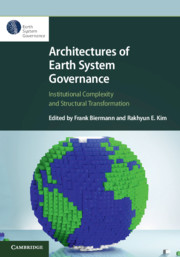Book contents
- Architectures of Earth System Governance
- Series page
- Architectures of Earth System Governance
- Copyright page
- Contents
- Contributors
- Acknowledgements
- 1 Architectures of Earth System Governance
- Part I The Building Blocks
- Part II Core Structural Features
- 6 Institutional Interlinkages
- 7 Regime Complexes
- 8 Governance Fragmentation
- Part III Policy Responses
- Part IV Future Directions
- Glossary
- Index
- References
8 - Governance Fragmentation
from Part II - Core Structural Features
Published online by Cambridge University Press: 17 April 2020
- Architectures of Earth System Governance
- Series page
- Architectures of Earth System Governance
- Copyright page
- Contents
- Contributors
- Acknowledgements
- 1 Architectures of Earth System Governance
- Part I The Building Blocks
- Part II Core Structural Features
- 6 Institutional Interlinkages
- 7 Regime Complexes
- 8 Governance Fragmentation
- Part III Policy Responses
- Part IV Future Directions
- Glossary
- Index
- References
Summary
This chapter analyzes the fragmentation of architectures of earth system governance. We start with a conceptualization of governance fragmentation and its relation to concepts such as polycentricity and institutional complexity. We then review the origins of governance fragmentation and its problematization, methodological approaches to studying fragmentation and the impacts and consequences of fragmentation. We conclude by identifying future research directions in this domain. Our research shows that fragmentation is ubiquitous, that it varies among policy areas and governance areas and that it is a variable that can be assessed in comparative research across policy areas and over time. The review is based on a comprehensive study of the literature on governance fragmentation over the last decade. We draw on a Scopus search on all articles published in the subject area of social sciences from 2009 to 2018, supplemented by additional studies, such as books, book chapters and a few policy briefs and working papers.
Keywords
- Type
- Chapter
- Information
- Architectures of Earth System GovernanceInstitutional Complexity and Structural Transformation, pp. 158 - 180Publisher: Cambridge University PressPrint publication year: 2020
References
- 5
- Cited by



